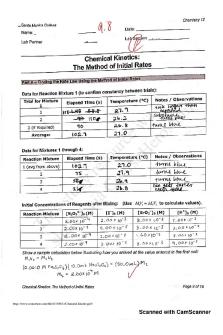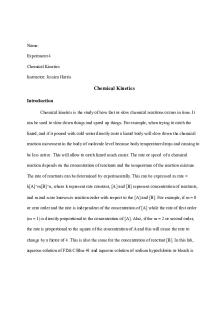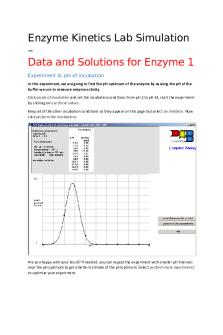Kinetics lab PDF

| Title | Kinetics lab |
|---|---|
| Author | Citlali Haro Franco |
| Course | (CHEM 2123, 2223, 2423) Organic Chemistry Laboratory |
| Institution | Texas A&M University |
| Pages | 3 |
| File Size | 210.4 KB |
| File Type | |
| Total Downloads | 61 |
| Total Views | 138 |
Summary
Kinetics lab report...
Description
Kinetics Study of SN1 Soilvolysis Lab Report Summary and Results: The experiment's objective is to determine a solvolysis reaction's kinetics and recognize how a change in solvent polarity affects a reaction's rate. The lab's objective was met by comparing the rate constants for the reaction of three different solvent systems in order to observe the effects of solvent polarity on the rate constant of the reaction. T he laboratory results are presented in the analytical and spectral information section of experiment 11 Kinetics in lab archives. The data sets of the three solutions analyzed are divided by a horizontal line, each with a graphical and table representation of data that will further be analyzed in this report's discussion section.
Solution #1: 50% ethanol, 50% water Figure 1
Table 1
Solution #2: 40% ethanol, 60% water Figure 2
Table 2
Kinetics Study of SN1 Soilvolysis Lab Report
Solution #3: 60% ethanol, 40% water Figure 3
Table 3
Discussion: The rate constant for solution #1 50% ethanol, 50% water, was 0.0005 s^-1. The rate constant for solution #2: 40% ethanol, 60% water was 0.0014 s^-1. Lastly, the rate constant for solution #3: 60% ethanol, 40% water was calculated to be 0.0001 s^-1. The derivation of the rate constant was obtained by calculating the slope of the equation. The mathematical derivation of the rate constant equation will be attached to the end of the report's discussion. In the graphs, different rate constants are observed for the different three solutions analyzed; the different rate constants are due to each respective solution's polarity concentration. The solutions' polar nature increases with the concentration increase of water in the solution due to waters polarity caused by hydrogen bonding in the water molecules. Hence, the most polar solution is derived from the second figure and table with the highest water concentration in the analyzed solution #2: 40% ethanol, 60% water. The solutions polar nature in decreasing order are as follows: solution 2 with 60% water, solution #1 with 50% water, and solution #3 with 40% water. For further explanation, the higher content percentage of water, alkyl chloride's resulting dissociation increases respectively and increases, in the context of the highest recorded rate constant solution, the second solution's rate constant. To put it differently, the more polar the reaction, this would result in a faster reaction rate as it stabilizes the carbocation. The same idea is observed in the other solutions graphs; however, with a smaller percentage of water, and as a result, a slower reaction rate is observed. Moreover, since the graphs were linear, it was confirmed that the solutions demonstrated first-order kinetics as described in the lab manual. Since the reaction has a 1:1 millimole ratio of hydronium ion for every 1-chloro-1-phenylethane, the acid formation in the reaction was at the same rate as alcohol formation. Hence, making the comparison of RCL used equal to the total
Kinetics Study of SN1 Soilvolysis Lab Report millimoles of HCL evolved and equal to NaOH'sNaOH's total millimoles used in the reaction (further analyzed in the derivation of equation 9 attachment). From the derived rate reaction equation determined to be first-order, the specific rate constant can be obtained at any specified time t from the similar y=mx+b calculated equation (x being time t and k the slope). Some possible sources of errors that may have taken place could have been improper preparation of the base concentrations and inconsistent recordings of the times of change of color in the titration procedure. To calculate the reaction rate constants, we plotted the time vs. ln (v-v)/(v-V) on graph and determined the reaction formula's rate from first-order kinetics (were k is equivalent to the slope of the graphs and is the rate constant with units of seconds ^-1). In the solvolysis sn1 reaction, the solvent of the reagent present was in excess. The reaction rate was utilized to observe how molecular interaction through the change of the solvent's polarity changed the kinetics solvolysis reaction rate as they changed over time. In the reaction, the solvent in the SN1 reaction was a nucleophile; the first step was the detachment of the leaving group generating a carbocation intermediate; following, the nucleophile attacked the electrophile carbocation to form a new bond. In an SN1 reaction, the solvents can only affect the rate of the reaction when carbocation intermediates are formed. The carbocation intermediates are stabilized by the polar solvent, which causes the reaction rate to increase. The higher the polarity, the faster the reaction rate of the kinetic reaction run. Overall, the experiment was successful as polarity effects were observed in the kinetics of solvolysis reactions.
Bibliography
Clement, B. A., & Harding, K. E. (2020). "Organic Chemistry Experiments." H ayden-McNeil, LLC. Accessed November 3, 2020....
Similar Free PDFs

Kinetics lab
- 3 Pages

Enzyme Kinetics Lab Simulation
- 4 Pages

Enzyme Kinetics Lab Report
- 14 Pages

Kinetics Pre Lab
- 2 Pages

Chemical Kinetics lab
- 9 Pages

Chemical Kinetics - lab report
- 4 Pages

Kinetics Lab Report
- 8 Pages

Lab #9 Enzyme Kinetics
- 10 Pages

Lab Report - Enzyme Kinetics
- 4 Pages

Lab 11 Chemical Kinetics Report
- 4 Pages

Enzyme Kinetics 5 - Lab report
- 8 Pages
Popular Institutions
- Tinajero National High School - Annex
- Politeknik Caltex Riau
- Yokohama City University
- SGT University
- University of Al-Qadisiyah
- Divine Word College of Vigan
- Techniek College Rotterdam
- Universidade de Santiago
- Universiti Teknologi MARA Cawangan Johor Kampus Pasir Gudang
- Poltekkes Kemenkes Yogyakarta
- Baguio City National High School
- Colegio san marcos
- preparatoria uno
- Centro de Bachillerato Tecnológico Industrial y de Servicios No. 107
- Dalian Maritime University
- Quang Trung Secondary School
- Colegio Tecnológico en Informática
- Corporación Regional de Educación Superior
- Grupo CEDVA
- Dar Al Uloom University
- Centro de Estudios Preuniversitarios de la Universidad Nacional de Ingeniería
- 上智大学
- Aakash International School, Nuna Majara
- San Felipe Neri Catholic School
- Kang Chiao International School - New Taipei City
- Misamis Occidental National High School
- Institución Educativa Escuela Normal Juan Ladrilleros
- Kolehiyo ng Pantukan
- Batanes State College
- Instituto Continental
- Sekolah Menengah Kejuruan Kesehatan Kaltara (Tarakan)
- Colegio de La Inmaculada Concepcion - Cebu




